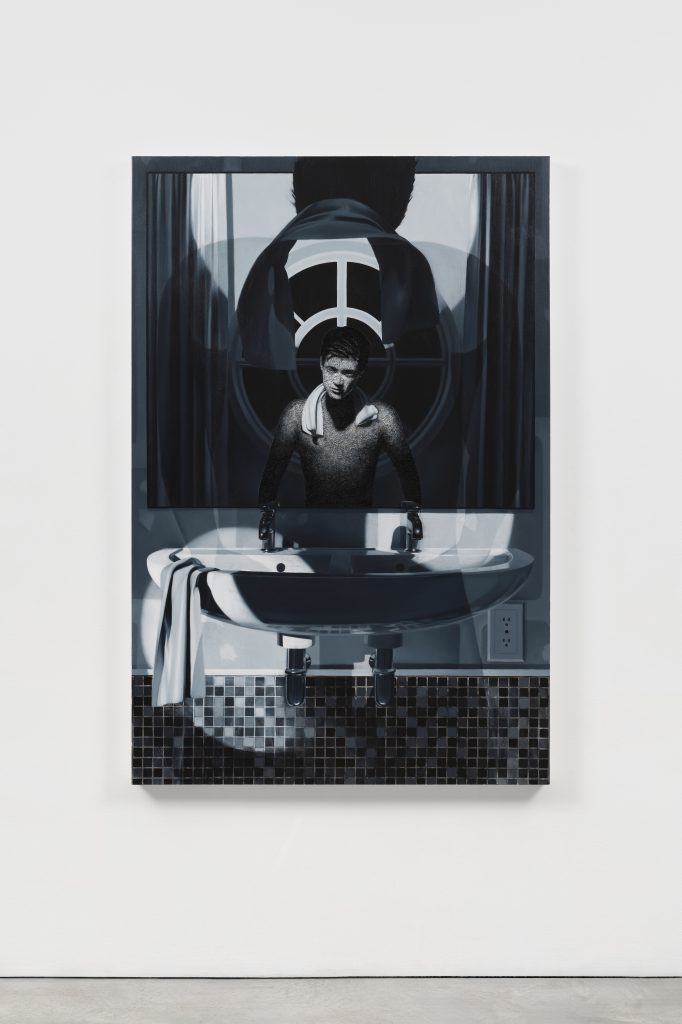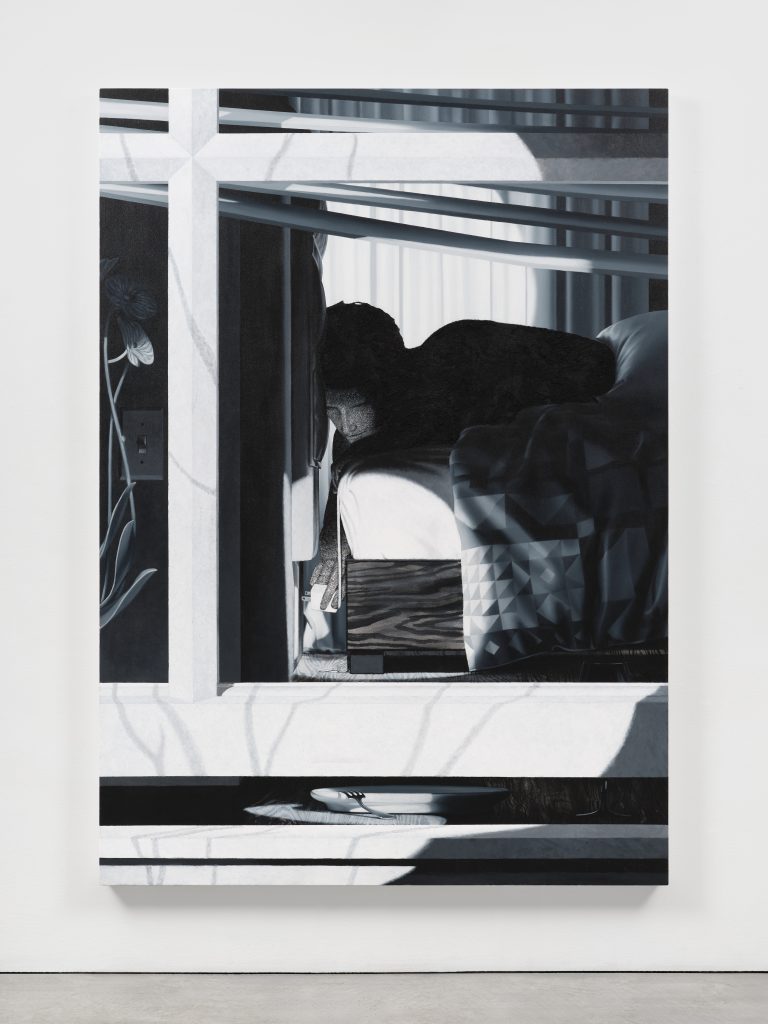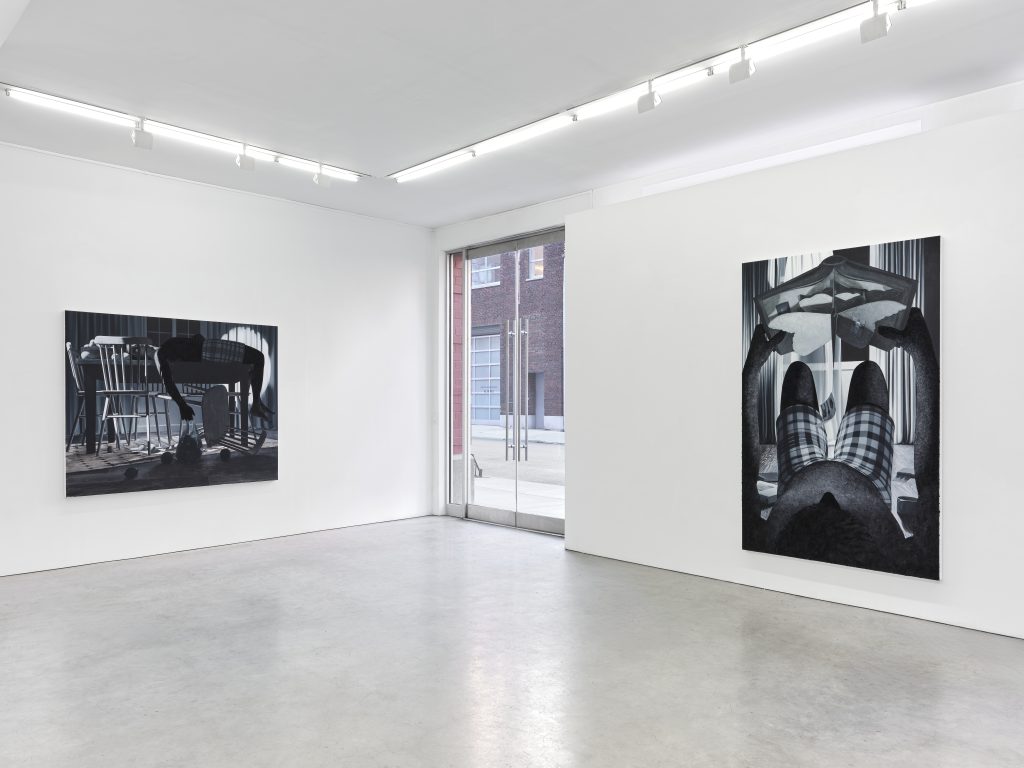In the paintings by Dustin Emory in a new exhibition at Fredericks & Freiser in New York, nothing is moving, and no one else is there.
Artistically realized individuals (perhaps all the same person) appear in isolation, framed by backdrops that seem sometimes an imposition and sometimes as something just left to itself. There is a lot of internal, assertive force to their forms, but they’re not reacting to anything or in direct, altering dialogue. It instead, again, imposes — a startlingly effective artistic vision.
Even the visually invoked light itself with its overarching ambiance, surface by surface both in each scene and in each overall artwork, is still, nearly locked in place, nearly suffocating… though not quite. It instead lingers as a downwardly pulling weight in the air.
The distinction between the personal and external — a distinction sharp enough that it approaches mockery by whatever’s left of the outside — is amplified by Emory’s addition of crushed pumice stone to the depiction of individual figures within their grayscale environments, which again and again suggest a domestic setting, though not one particularly full of the markers of actual, active use.
The indications of obstructive shadow in these scenes also feel halted: a waiting pause of uncertainty in which the lack of forward structure becomes what’s left. The stasis becomes the state of being, reflected across each of Emory’s created locations.
His art in this showcase, titled “Mourning Sun,” is all figurative, and it is all suggestive of a specific, even if sometimes mysterious place. These environments languish and loom without giving something back. There’s no spatial, relational circulation between the figures who occupy Emory’s paintings and the settings around them, the scenes that suggest a lived day but don’t fully materialize it, leaving its fullness tangibly just out of reach, with the sense of something brighter just around the room’s corner but not here.
Impactfully, these environments and the weight you feel behind them — something gnawing, maybe crushing if it went on too long — seem to demand, to pull if anything, but the precise specifics of their demands refuse clarity.
In the sense of truly seeing, as much as looking and looking at looking and looking for… something is a core part of this collection of artworks, the surroundings in each instance really aren’t looking back. But they’re not… entirely gone, placed or moving somewhere else, or someone else’s problem. They remain, their cold presence jarring. They’re walls amid which there was, maybe, once life, amid which there was once… more, but now, they simply shudder under the weight of absence.
The ensnaring settings for these painted scenes are defined by the relentless, trudging totality of their separation from the figures within them, moment by moment, glance by glance, and line by line. They’re a force that does not intermingle. If you linger too long within the spatial, environmental indifference, it threatens madness, or at least the grueling tension of a slog towards something that circumstances keep just that: a slog.
Those who you can imagine lived within the environments of these paintings, you get the sense that they tried, they did reach, and maybe somewhere, they are still reaching. But caught in moments of contemplation, they’re now left searching, waiting, stopping: weighted down into their sometimes sprawled positions by a force unseen but distinct, and felt.
Amid that, there’s still… someone here, and their environments are still sensorily reachable. They’re still comprehensible, thunderous, and real… which makes the sharpness of their defining particularity all the more grueling. You can sense it, but you’re not part of it.
A discussion of the exhibition shared by the gallery connects the feeling and direction of Emory’s art to struggles faced by lower income Americans squaring off with systematic, structural hurdles. In the art, I see a carryover of this sometimes shattering confrontation between the personal and social or collective into an internalized state, an imposed place that changes, or at least redirects the experience of… everything, forcing ambition to slow down. And that kind of life calculus-redirecting break can trace to more directly personal, though also shared, hurdles as well, like the death of someone close.
So, the paintings come across like images of a place in which vestiges of a wish, reflections of an ambition: they all begin to stack atop each other, culminating in a gnawing, internal tension of unfulfillment in direct conjunction with still wanting the original object, the original place you were after. But the want becomes an encompassing definition.
You’re left waiting, wondering, and asking, until the newness of doing those things, the need to cross a rhetorical, mental bridge, is no longer there. The languid becomes the all.
And the heart that you know originally drove the construction and assemblage of any of this remains, waiting. I don’t know if the fulfillment of its wish will come, but the vantage point is no longer a sequence or unfolding of waiting, it’s an entirety of it.
Emory’s paintings, as jarring aesthetically as they are, remain defiantly human, and, even if painfully, inhabited. It’s a materialization of a feeling that’s simple and straightforward, but sweeping and encompassing. I’m still here.
Emory’s exhibition at Fredericks & Freiser continues through April 19. There’s an accompanying exhibition also showcasing the artist at Margot Samel, another New York gallery.



Featured image: Dustin Emory: Mourning Sun (installation view), Fredericks & Freiser, NY, March 20 – April 19, 2025. Courtesy of Fredericks & Freiser, NY.
You may also like
-
Diana Kurz at Lincoln Glenn in New York: A Review of a Shining Art Exhibition
-
Dustin Hodges at 15 Orient in New York City: An Ensnaring Exhibition at an Exciting Gallery
-
Maren Hassinger at Susan Inglett Gallery in New York: Reviewing an Uplifting Art Exhibition
-
Enzo Shalom at Bortolami in New York City: Reviewing an Entrancing Exhibition of Paintings
-
“Ben Werther: Townworld” at Amanita in New York City: Reviewing a Richly Memorable Art Exhibition
